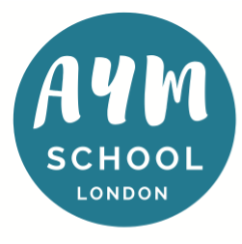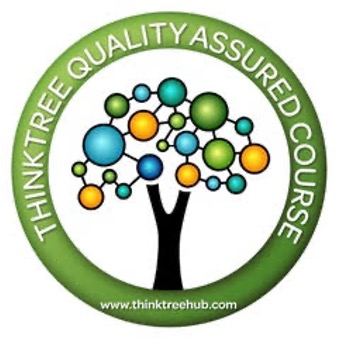Ayurvedic Yoga Massage:
The Healing Wisdom of India in Your Hands – And Feet
You can now train in Ayurvedic Yoga Massage in the UK to a professional level on a ThinkTree accredited course. The Ayurvedic Yoga Massage Professional Diploma offered by Ayurvedic Yoga Massage School London, based in Islington, contains all you need to go from absolute beginner to fully qualified massage therapist. Course units are also available for qualified massage therapists to expand their menu of treatments to include Ayurvedic Yoga Massage.

What is Ayurvedic Yoga Massage?
Ayurvedic Yoga Massage combines the best elements of traditional Ayurvedic massage and Iyengar yoga to create a powerful, varied and rewarding oil massage that impresses all who receive it with its thoroughness, diversity and depth of impact.
Ayurvedic Yoga Massage uses a variety of techniques to warm up the muscular system, to improve the blood and lymph circulation, to align the musculoskeletal system, and increase vital energy (prana). In this mat-based massage, hands and feet are used as tools with the use of feet allowing for a more thorough deep tissue effect. A combination of passive yoga stretches is included to help the mobility of the joints and to release tension in the muscles. Pure organic vegetable oil is used for the massage together with calamus powder, an Ayurvedic medicinal ingredient, helping to balance the body elements (doshas), improve circulation and release toxins. At the end of the session the receiver feels deeply relaxed and rejuvenated.
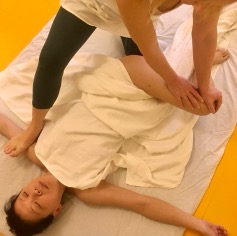
What is the origin of Ayurvedic Yoga Massage?Ayurvedic Yoga Massage was created in the early 1980s by Kusum Modak who studied yoga with the world-famous guru BKS Iyengar for 20 years and also learnt therapeutic massage through an apprenticeship with an experienced Ayurvedic Massage therapist in Pune, India.
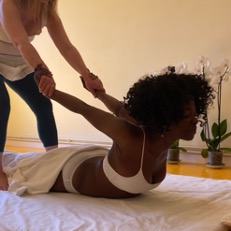
She incorporated elements of her yoga practice into massage to create Ayurvedic Yoga Massage and worked tirelessly for 35 years to offer treatments and training. She became known to disciples of Osho, an Indian guru who had a large Western following, which meant that her practice and teaching touched the lives of many people from all around the world. Debbie Joy, the tutor of Ayurvedic Yoga Massage School London, studied Ayurvedic Yoga Massage in India with one of Kusum’s students, and is pleased to continue this lineage by now making training in this unique massage style available in the UK.
What is unique about Ayurvedic Yoga Massage?
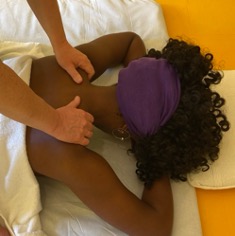
There are several elements of this massage that combine to elevate it as a massage style. Together, these elements create a detailed, powerful and impactful bodywork experience for the client. As a therapist it is exciting to have techniques in your toolkit that go so far beyond the standard western massage routines and leave clients so satisfied with their treatment:
- as a student, you will learn a detailed flowing sequence that covers the whole body. The therapist first uses their hands to warm up muscles and fascia, boosting circulation and relieving muscular tension
- once an area of the body has been opened up it is possible to take the treatment deeper by incorporating stretches based on yoga asanas. Here it is possible to see a similarity with traditional Thai massage and the idea of lazy man’s yoga as the receiver relaxes during the stretches rather than making the effort required in a yoga practice. Joints are mobilised with stagnation eliminated and flexibility enhanced
- a special feature of Ayurvedic Yoga Massage is that the therapist also massages with their feet on the back of the body. The use of the feet in massage is traditional in India with Chivutti Thirummal – a robust deep tissue massage designed for the martial artists of Kerala. It is an excellent way for the therapist to apply powerful strokes without overworking themselves. In Ayurvedic Yoga Massage it offers a special grounding energy and a sense of surrender to the weight of the massage therapist. It offers a deep tissue massage experience that many clients crave, without placing strain on the therapist
- we use vaikhand powder as well as vegetable oil as our medium. Vaikhand is an Ayurvedic herbal medicine, called calamus in English, a powdered reed root that stimulates the circulation of lymph and blood and enhances the body’s natural detoxification system
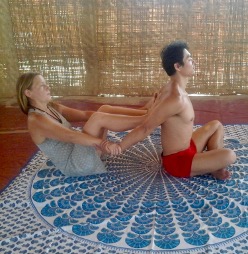
- working on a floor-based mat, the therapist has gravity on their side assisting their efforts. Many different positions are taken up by the therapist making it a sacred dance around the client. The training course teaches you to take up the most suitable body position for each element of the massage to ensure no strain occurs and that the act of massaging enhances your own well-being as well as that of your clients
- with a foundation in the ancient practice of yoga, Ayurvedic Yoga Massage aims to create a spiritually uplifting experience enabling the client to open up to oneness through deep relaxation and connection with the therapist
Where can I find more information about training in AYM?
Please take a look at the Ayurvedic Yoga Massage School London website for full details of the training course as well as training dates:
Contacts:
Email: glitterdebbie@gmail.com
Website: www.ayurvedicyogamassageschool.co.uk
Tel: 07792579595
